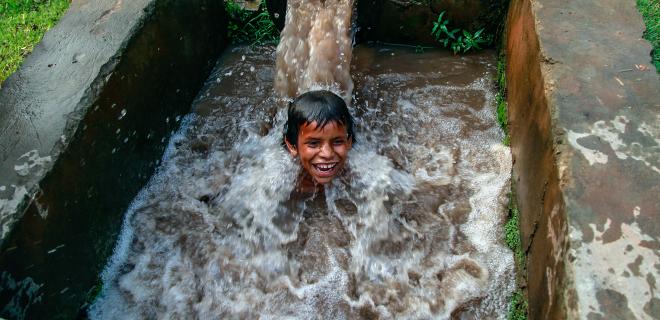
2009 Eric Sales/ Asian Development Bank
Water is the primary medium through which we will feel the effects of climate change. Water availability is becoming less predictable, increased incidences of flooding threaten to destroy water points and sanitation facilities, and water sources are in danger of contamination.
An integrated view on water, the biosphere, and environmental flows is required to devise sustainable agricultural and economic systems that will allow us to decelerate climate change, protect us from extremes, and to adapt to the unavoidable. — Read More @ UN Water »
International development projects are integral in the promotion of water use sustainability, the mitigation of climate change effects, and the improvement water sanitation and accessibility.

"Ever since they made a new canal, there is more water available for locals here. I love taking a bath here." — Haseeb, 8, enjoys a bath in water that was pumped from the Lower Bari Duab Canal in Punjab, Pakistan.
Irrigation and Agriculture
Punjab Irrigated Agriculture Investment Program — Project 1 | Pakistan (Completed 2018)
The Asian Development Bank (ADB) supported and worked with Pakistan to improve water resource management and increase the productivity of irrigated agriculture in the Punjab province. The project consisted of rehabilitating irrigation infrastructure and improving the management of ground and surface water.

Najma, 27, cuts the wheat crop near Lower Bari Doab Canal near Balloki headworks in Punjab, Pakistan. Ever since the construction of the canal, the production of crops has increased which has ensured more work for farmers and laborers.

Climate Resilience and Adaptation
Building Climate Resilient Watersheds in Mountain Eco-Regions | Nepal
The building of climate resilient watersheds in Mountain Eco-Regions has improved water management and provided a usable supply of water for use in the home and for agriculture in about 100 communities in Nepal. Under changing climate conditions, the project has helped in increasing the reliability and availability of water in hill and mountain watersheds in the Far West of Nepal.
Community and Urban Infrastructure
Second Chittagong Hill Tracts Rural Development Project | Bangladesh
Asian Development Bank (ADB) helped in improving Bangladesh livelihoods in the ethnically unique and geographically isolated Chittagong Hill Tracts. The project funded institutional development and capacity building, rural access roads and markets, village infrastructure, and the development of micro-agribusinesses.
 Marma women return home from the village market in Boli Para, Thanchi, Banderban. Together with ADB, improvements are being made in Bangladesh livelihoods in the ethnically unique and geographically isolated Chittagong Hill Tracts.
Marma women return home from the village market in Boli Para, Thanchi, Banderban. Together with ADB, improvements are being made in Bangladesh livelihoods in the ethnically unique and geographically isolated Chittagong Hill Tracts.

Routine check done by the sewage treatment plant staff in Delawas, Jaipur. The plant is part of the ADB best practices projects list. Teams from Pakistan, Nepal, Bangladesh, and Philippines have visited the plant to study its model.

Machine filtering the trash at the sewage treatment plant in Delawas, Jaipur, India. The plant is part of the ADB best practices projects list. Teams from Pakistan, Nepal, Bangladesh and Philippines have visited the plant to study its model.
Rajasthan Urban Infrastructure Development Project | India
The Rajasthan Urban Infrastructure Development Project was designed to respond to the lagging urban development in India. Economic growth stimulated urbanization, but the investment in urban infrastructure and services did not from proportionally.
This lag resulted in the deterioration in the quality of life of the people and resulted in severe social and public health problems. The poor, women, and children were especially disadvantaged. The situation is expected to worsen at an accelerating pace unless extensive urban renewal occurs. Comprehensive policies, institutional reforms, and capacity building are needed to put a stop to this deterioration, along with the provision of expanded infrastructure and services in almost every aspect of urban development — such as water, sanitation, sewage, solid waste management, roads, hospitals, and protection of historic sites.
The project sought to improve social and economic life in urban Rajasthan through policy reforms geared to strengthen urban management and lend support to priority investments in urban infrastructure and services. Its aim was to meet basic human needs, improve the general quality of life, and stimulate sustainable development. The overall goal of the project was to alleviate the detrimental and difficult living conditions of the urban poor, particularly women and children.
Water Sanitation and Accessibility
 Sewer network rehabilitation and expansion works at the Malakal and Meyuns area. The Koror-Airai Sanitation Project aims to improve sanitation services in Airai and Koror, where about 80% of the country’s population live.
Sewer network rehabilitation and expansion works at the Malakal and Meyuns area. The Koror-Airai Sanitation Project aims to improve sanitation services in Airai and Koror, where about 80% of the country’s population live.
 Aerial shot of Palau at the location of the Koror-Airai Sanitation Project.
Aerial shot of Palau at the location of the Koror-Airai Sanitation Project.

Sustainable Development Goals
UNDB is committed to the Sustainable Development Goals (SDGs) Decade of Action.
Goal 6: Ensure access to water and sanitation for all. Access to safe water, sanitation and hygiene is the most basic human need for health and well-being. Billions of people will lack access to these basic services in 2030 unless progress quadruples. Demand for water is rising owing to rapid population growth, urbanization and increasing water needs from agriculture, industry, and energy sectors.
International development projects provide financial, technical, and organizational support for biodiversity conservation in developing regions.
UNDB supports Goal 6 by promoting and encouraging investment in biodiversity conservation projects.


